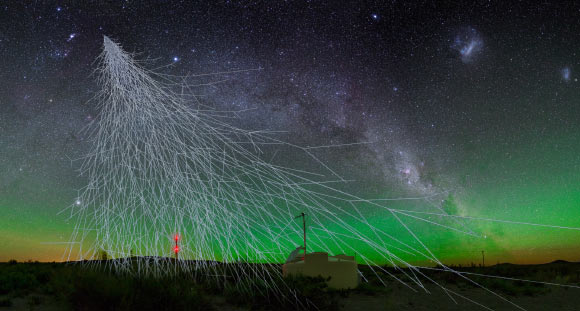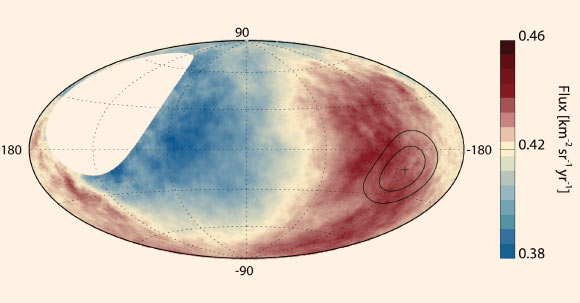For the first time, astrophysicists have confirmed that cosmic rays with ultra-high energies come from outside our Milky Way Galaxy.

At the Pierre Auger Observatory in Argentina, cosmic rays have been detected from far off galaxies. Image credit: A. Chantelauze / S. Staffi / L. Bret / Pierre Auger Observatory.
Cosmic rays are atomic nuclei arriving from outer space that can reach the highest energies (exa-electronvolt) observed in nature.
Low-energy cosmic rays come from the Sun or from our own Galaxy, but the origin of the highest-energy particles has been the subject of debate ever since they were first discovered 50 years ago: do they come from the Milky Way or from extragalactic objects?
“We are now considerably closer to solving the mystery of where and how these extraordinary particles are created, a question of great interest to astrophysicists,” said Karl-Heinz Kampert, a professor at the University of Wuppertal in Germany and spokesperson for the Auger Collaboration, which operates the largest cosmic-ray observatory ever built.
“At the Pierre Auger Observatory, cosmic rays are detected by measuring the Cherenkov light — electromagnetic radiation emitted by charged particles passing through a medium, such as water, at greater than the phase velocity of light in that medium,” Professor Kampert and colleagues explained.
“We measure the Cherenkov light produced in a detector, which is a large plastic structure that contains 12 tons of water. They pick up a signal in a few detectors within an array of 1,600 detectors.”
“The detectors are spread over 3,000 km2 near the town of Malargüe in western Argentina. The times of arrival of the particles at the detectors, measured with GPS receivers, are used to determine the direction from which the particles came within approximately one degree.”

This map showing the cosmic ray flux; the region showing an excess of cosmic rays is circled; the center of the Milky Way Galaxy is at the center of the ellipse. Image credit: Pierre Auger Collaboration.
The astrophysicists with the Auger Collaboration analyzed data recorded at the observatory between 1 January 2004 and 31 August 2016.
During this time, about 30,000 cosmic particles with ultra-high energies (above 8*1018 electron volts) were detected.
Intriguingly, their arrival directions are not evenly distributed across the sky, but favor a certain direction.
“This alignment direction indicates that these ultra-high energy particles must have originated in other galaxies,” the researchers said.
University of Nebraska-Lincoln Professor Gregory Snow, education and outreach coordinator for the Pierre Auger Observatory project, added: “the Sun emits low-energy cosmic ray particles that are detected here on Earth, but they are nowhere near as high energy as the particles detected at the Auger Observatory.”
“The particles we detect are so energetic they have to come from astrophysical phenomena that are extremely violent.”
“Some galaxies have an explosive, massive black hole in their centers and there are theories that these very violent centers accelerate particles of very high energy that eventually reach Earth.”
“By understanding the origins of these particles, we hope to understand more about the origin of the Universe, the Big Bang, how galaxies and black holes formed and things like that. These are some of the most important questions in astrophysics,” Professor Snow said.
Details of the research were recently published in the journal Science.
_____
A. Aab et al (The Pierre Auger Collaboration). 2017. Observation of a large-scale anisotropy in the arrival directions of cosmic rays above 8×1018 eV. Science 357 (6357): 1266-1270; doi: 10.1126/science.aan4338







